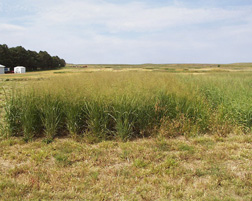Read the
magazine
story to find out more.
|

Native grasses like switchgrass may contribute to
soils with higher levels of glomalin, a glycoprotein that helps store carbon
and may increase the value of the grass as a source of ethanol. Click the
image for more information about it.
|

|
Switchgrass May Mean Better Soil
By Don Comis
July 17, 2008 Soils with native grasses such as
switchgrass have higher levels of a key soil component called glomalin than
soils planted to non-native grasses, according to a study by the
Agricultural Research Service at two
locations in Mandan, N.D.
Kristine
Nichols, a microbiologist with the
ARS
Northern Great Plains Research Laboratory in Mandan, conducted the study.
Glomalin is a sugar-protein compound that might trigger the formation of soil.
The more glomalin in a given soil, the better and less erosion-prone that soil
probably is.
In 2004, Nichols collected soil from under grass plots established between
1987 and 2002. The amount of glomalin in the soil increased as the degree of
interdependence between plants and the arbuscular mycorrhizal fungi increased.
These fungi produce glomalin and live inside plant roots and the surrounding
soil. That interdependence is greatest in warm-season native grasses such as
switchgrass, blue grama, big bluestem and indiangrass.
Further evidence that soils underneath native grasses are higher in glomalin
came from another study on rangeland areas at Mandan and near Platte, S.D.
In an earlier study, Nichols analyzed samples from undisturbed soils with
native vegetation in Maryland, Georgia and Colorado. According to her analysis,
glomalin stored a large percentage of the carbon found in those soils and
contributed greatly to soil fertility. On average, glomalin stored 15 percent
of the soil carbon, with the highest amount—30 percent— in a Colorado
soil and the lowest amount—9 percent—in a Georgia soil. These results
are similar to those from other soil samples taken around the world.
The increased glomalin and underground carbon storage observed with
switchgrass adds to its value as a potential source of cellulosic ethanol.
Nichols uses glomalin measurements as a quick guide to evaluate how
"soil-friendly" farming or rangeland practices actually are. She
originally worked with soil scientist Sara Wright, who discovered and named
glomalin in 1996. Wright has since retired.
Read
more about the research in the July 2008 issue of Agricultural Research
magazine.
ARS is a scientific research agency of the U.S. Department of Agriculture.